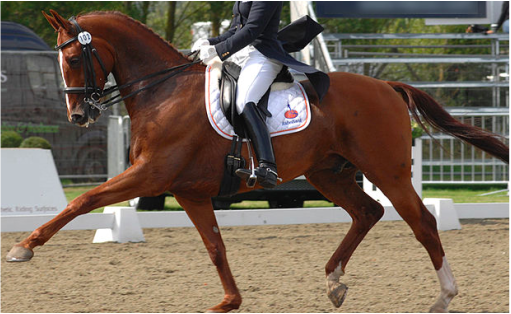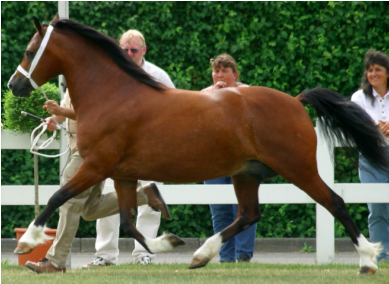How To Lengthen A Horse's Gait
Here are the steps to lengthen a horse's stride.
"Not enough extension", the dressage judge wrote in her comments. "Horse got faster rather than lengthening."
If Sarah got that comment one more time on her dressage tests, she thought she was going to scream. In an effort to get her horse to extend his trot and canter, Sarah squeezed her legs, she dug her seat bones into his back to drive him forward, she began wearing spurs with longer shanks…she pretty much tried everything. Yet her horse just got faster rather than extending.
To see the difference between "faster" and "lengthening" (or "extending"), here is a horse in his early stages of training that gets quicker in the trot rather than extending (from 1:30 to about 2:15).
If Sarah got that comment one more time on her dressage tests, she thought she was going to scream. In an effort to get her horse to extend his trot and canter, Sarah squeezed her legs, she dug her seat bones into his back to drive him forward, she began wearing spurs with longer shanks…she pretty much tried everything. Yet her horse just got faster rather than extending.
To see the difference between "faster" and "lengthening" (or "extending"), here is a horse in his early stages of training that gets quicker in the trot rather than extending (from 1:30 to about 2:15).
In contrast, this horse is farther along in his training. He has been taught to lengthen his stride in the trot. Notice that he covers more ground with each step, and his pace doesn't change. The rider rises at the same even tempo, but her horse gets from one place to another a lot faster.
One of the best explanations of extended gaits I've ever come across is in Walter Zettl's book Dressage in Harmony and accompanying videos. As he points out, the first step in developing extension is releasing the hands slightly forward so that the horse stretches and lengthens his frame to re-establish contact with the hands. As the horse's body stretches and lengthens, his gait lengthens as well.
In the photo on the left, the rider is not releasing her hands forward. It is difficult for a horse to extend his gaits when held in this way, but he will try his best. Usually this means that his front legs will swing wildly out in front while his back legs fail to lengthen their stride. The result is a gait that resembles a Spanish Walk rather than a gait extension, and that is not what a dressage judge is looking for. Contrast this artificial lengthening with the way a horse lengthens on his own when unhampered by a rider's restraining hands.
The steps to lengthen a horse's gait
1. Make sure you have a secure, following seat.
If you are gripping anywhere, your horse will tense his body in response and this will interfere with his attempts to lengthen.
Three Secrets To A Secure Seat
2. Make sure you have an elastic rein contact.
The key to extension is that when you push your hands slightly forward, your horse stretches his head, neck, and body in an attempt to re-establish contact. If your hands are stiff, rigid, loosey-goosey, or twitchy, he will feel nothing but relief when you release your hands forward, and will hardly be interested in res-establishing contact with those unpleasant feelings. In this video, you can see how unsteady the rider's hands are--and this rider is using a double bridle! The horse is doing the best she can to do what is asked, but that "in and out" and unsteady contact makes it difficult for her.
Elastic-Contact: How to develop elastic rein contact
3. Make sure you know how to execute a REAL half halt. No, that doesn't mean slowing your horse down or pulling on the reins halfway.
How To Half Halt Your Horse
4. Make sure you know how to engage his hindquarters.
In extension, you need to "wind up" your horse's energy in his powerful haunches, then allow that energy to explode forward into your slightly released hands.
How to Engage a Horse's HIndquarters
5. Now you're ready to teach your horse to extend.
Follow these steps:
- Put your horse into a nice working trot, establishing a comfortable rhythm.
- Trot down the long side of the arena.
- When you approach the corner, half halt to shift his weight back onto his haunches, shorten your reins so that you take a firmer contact. Ride him this way through the short side and through the next corner.
- As you begin trotting down the long side, push your hands slightly forward towards his nose so that the rein contact softens just a bit (a very little will do), weight your seat bones a bit more, and squeeze your legs at or slightly behind the girth.
Your horse should reach his head and neck forward in an effort to re-establish contact with your hands. The release should also allow all that power you built up on the short side to explode forward toward your hands. Squeezing your legs will encourage him to lengthen his body. And voila! You've got the perfect trot extension.
Practice this pattern a few times so that you and your horse become accustomed to the feeling of containing the energy and letting it rush forward, winding up his body and letting it lengthen. Then try extending across the diagonal of the arena, being careful again to shorten his frame and gather his energy in the corners and short side of the arena.
6. Now try it in canter
When you've got this down pat in trot, practice the same patterns in canter:
Happy riding!
Copyright Denise Cummins April 12, 2016; updated June 23, 2024
The Thinking Equestrian
As long as you’re here, check these out!
Equestrian Products That Make Your Riding and Horse Care Easier and Better!
Get Fit To Ride!
Dressage for Everyone
How To Leg Yield or Side Pass A Horse
What’s the Difference Between Working, Medium, and Extended Trot?
Opening Photo Credit: By Nikki [CC BY-SA 2.0 (http://creativecommons.org/licenses/by-sa/2.0)], via Wikimedia Commons
Left Photo Credit: By Original work by: User:Chefsna From:nl.wikipedia [GFDL (http://www.gnu.org/copyleft/fdl.html) or CC BY-SA 3.0 (http://creativecommons.org/licenses/by-sa/3.0)], via Wikimedia Commons
Right Photo Credit: By User:MBurger (Own work) [GFDL (http://www.gnu.org/copyleft/fdl.html) or CC-BY-SA-3.0 (http://creativecommons.org/licenses/by-sa/3.0/)], via Wikimedia Commons
6. Now try it in canter
When you've got this down pat in trot, practice the same patterns in canter:
- Canter your horse down the long side of the arena
- Half halt in the corners to gather her energy and shorten her body
- Hold that energy on the short side
- Let her explode down the long side of the arena by pushing your hands slightly forward.
Happy riding!
Copyright Denise Cummins April 12, 2016; updated June 23, 2024
The Thinking Equestrian
As long as you’re here, check these out!
Equestrian Products That Make Your Riding and Horse Care Easier and Better!
Get Fit To Ride!
Dressage for Everyone
How To Leg Yield or Side Pass A Horse
What’s the Difference Between Working, Medium, and Extended Trot?
Opening Photo Credit: By Nikki [CC BY-SA 2.0 (http://creativecommons.org/licenses/by-sa/2.0)], via Wikimedia Commons
Left Photo Credit: By Original work by: User:Chefsna From:nl.wikipedia [GFDL (http://www.gnu.org/copyleft/fdl.html) or CC BY-SA 3.0 (http://creativecommons.org/licenses/by-sa/3.0)], via Wikimedia Commons
Right Photo Credit: By User:MBurger (Own work) [GFDL (http://www.gnu.org/copyleft/fdl.html) or CC-BY-SA-3.0 (http://creativecommons.org/licenses/by-sa/3.0/)], via Wikimedia Commons



